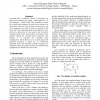Free Online Productivity Tools
i2Speak
i2Symbol
i2OCR
iTex2Img
iWeb2Print
iWeb2Shot
i2Type
iPdf2Split
iPdf2Merge
i2Bopomofo
i2Arabic
i2Style
i2Image
i2PDF
iLatex2Rtf
Sci2ools
ANSS
2003
IEEE
2003
IEEE
An Event-Driven Approach to Crosstalk Noise Analysis
Crosstalk noise evaluation consists in analysing the effect of the transition of a signal - called aggressor - on its neighbours - called victims. This evaluation is based on a model that estimates the peak noise produced on each victim. However, from a victim’s point of view, not all its aggressors are able to make a transition at the same time. Thus, determining the active aggressors of a victim at a given time is a key point to get a realistic estimation of the noise. In this paper, we present a static analysis method for crosstalk noise evaluation. The purpose is to calculate the “maximal noise configuration” that is likely to occur of each signal. The proposed approach is based on an event-driven algorithm. First, the instability periods of signals are calculated. Then, using these periods, the maximal noise configuration is obtained for each victim.
| Added | 04 Jul 2010 |
| Updated | 04 Jul 2010 |
| Type | Conference |
| Year | 2003 |
| Where | ANSS |
| Authors | Pirouz Bazargan-Sabet, Patricia Renault |
Comments (0)

